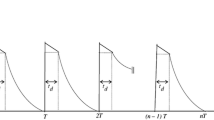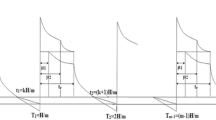Abstract
This paper develops an economic ordering policy model for non-instantaneous deteriorating items with selling price- and inflation-induced demand under the effect of inflation, permissible delay in payments and customer returns. Shortages are allowed and partially backlogged. The customer returns are assumed to increase with both the quantity sold and the product price. The main objective is to determine the optimal selling price, the optimal length of time in which there is no inventory shortage, and the optimal replenishment cycle simultaneously, to minimize the present value of the total profit. An efficient algorithm is presented to find the optimal solution of the developed model. Finally, a numerical example is extracted to solve the presented inventory model using the proposed algorithm.






Similar content being viewed by others
References
Abad, P. L. (1996). Optimal pricing and lot sizing under conditions of perishability and partial backordering. Management Science, 42, 1093–1104.
Abad, P. L. (2001). Optimal price and order size for a reseller under partial backordering. Computer and Operations Research, 28, 53–65.
Anderson, E. T., Hansen, K., Simister, D., & Wang L. K. (2006). How are demand and returns related? Theory and empirical evidence. Working paper, Kellogg School of Management, Northwestern University.
Balkhi, Z. (2011). Optimal economic ordering policy with deteriorating items under different supplier trade credits for finite horizon case. International Journal of Production Economics, 133, 216–223.
Bose, S., Goswami, A., & Chaudhuri, K. S. (1995). An EOQ model for deteriorating items with linear time-dependent demand rate and shortages under inflation and time discounting. Journal of the Operational Research Society, 46, 771–782.
Buzacott, J. A. (1975). Economic order quantities with inflation. Operational Research Quarterly, 26, 553–558.
Chang, H. J., Teng, J. T., Ouyang, L. Y., & Dye, C. Y. (2006). Retailer’s optimal pricing and lot-sizing policies for deteriorating items with partial backlogging. European Journal of Operational Research, 168, 51–64.
Chang, C. T., Teng, J. T., & Goyal, S. K. (2010). Optimal replenishment policies for non instantaneous deteriorating items with stock-dependent demand. International Journal of Production Economics, 123, 62–68.
Chao, X., Gong, X., & Zheng, S. (2014). Optimal pricing and inventory policies with reliable and random-yield suppliers: Characterization and comparison. Annals of Operations Research. doi:10.1007/s10479-014-1547-0.
Chen, J., & Bell, P. C. (2009). The impact of customer returns on pricing and order decisions. European Journal of Operational Research, 195, 280–295.
Covert, R. P., & Philip, G. C. (1973). An EOQ model for items with Weibull distribution deterioration. AIIE Transaction, 5, 323–326.
Datta, T. K., & Pal, A. K. (1991). Effects of inflation and time value of money on an inventory model with linear time-dependent demand rate and shortages. European Journal of Operational Research, 52, 326–333.
Dye, C. Y. (2007). Joint pricing and ordering policy for a deteriorating inventory with partial backlogging. Omega, 35, 184–189.
Dye, C. Y., Ouyang, L. Y., & Hsieh, T. P. (2007a). Inventory and pricing strategy for deteriorating items with shortages: A discounted cash flow approach. Computers and Industrial Engineering, 52, 29–40.
Dye, C. Y., Ouyang, L. Y., & Hsieh, T. P. (2007b). Deterministic inventory model for deteriorating items with capacity constraint and time-proportional backlogging rate. European Journal of Operational Research, 178, 789–807.
Geetha, K. V., & Uthayakumar, R. (2010). Economic design of an inventory policy for non-instantaneous deteriorating items under permissible delay in payments. Journal of Computational and Applied Mathematics, 223, 2492–2505.
Ghare, P. M., & Schrader, G. H. (1963). A model for exponentially decaying inventory system. International Journal of Production Research, 21, 449–460.
Gholami-Qadikolaei, A., Mirzazadeh, A., & Tavakkoli-Moghaddam, R. (2013). A stochastic multiobjective multiconstraint inventory model under inflationary condition and different inspection scenarios. Proceedings of the Institution of Mechanical Engineers, Part B: Journal of Engineering Manufacture, 227, 1057–1074.
Ghoreishi, M., Arshsadi-Khamseh, A., & Mirzazadeh, A. (2013a). Joint optimal pricing and inventory control for deteriorating items under inflation and customer returns. Journal of Industrial Engineering, 2013, ID 709083.
Ghoreishi, M., Mirzazadeh, A., & Weber, G. W. (2013b). Optimal pricing and ordering policy for non-instantaneous deteriorating items under inflation and customer returns. Optimization. doi:10.1080/02331934.2013.853059.
Ghoreishi, M., Mirzazadeh, A., & Nakhai-Kamalabadi, I. (2014). Optimal pricing and lot-sizing policies for an economic production quantity model with non-instantaneous deteriorating items, permissible delay in payments, customer returns, and inflation. Proceedings of the Institution of Mechanical Engineers, Part B: Journal of Engineering Manufacture. doi:10.1177/0954405414522215.
Goal, S., Gupta, Y. P., & Bector, C. R. (1991). Impact of inflation on economic quantity discount schedules to increase vendor profits. International Journal of Systems Science, 22, 197–207.
Goyal, S. K., & Giri, B. C. (2001). Recent trends in modeling of deteriorating inventory. European Journal of Operational Research, 134, 1–16.
Guria, A., Das, B., Mondal, S., & Maiti, M. (2013). Inventory policy for an item with inflation induced purchasing price, selling price and demand with immediate part payment. Applied Mathematical Modeling, 37, 240–257.
Hall, R. W. (1992). Price changes and order quantities: Impacts of discount rate and storage costs. IIE Transactions, 24, 104–110.
Hariga, M. A., & Ben-Daya, M. (1996). Optimal time varying lot sizing models under inflationary conditions. European Journal of Operational Research, 89, 313–325.
Hess, J., & Mayhew, G. (1997). Modeling merchandise returns in direct marketing. Journal of Direct Marketing, 11, 20–35.
Horowitz, I. (2000). EOQ and inflation uncertainty. International Journal of Production Economics, 65, 217–224.
Hsieh, T. P., & Dye, C. Y. (2010). Pricing and lot-sizing policies for deteriorating items with partial backlogging under inflation. Expert Systems with Applications, 37, 7234–7242.
Maihami, R., & Nakhai-Kamalabadi, I. (2012). Joint pricing and inventory control for non-instantaneous deteriorating items with partial backlogging and time and price dependent demand. International Journal of Production Economics, 136, 116–122.
Mirzazadeh, A., Seyed-Esfehani, M. M., & Fatemi-Ghomi, S. M. T. (2009). An inventory model under uncertain inflationary conditions, finite production rate and inflation-dependent demand rate for deteriorating items with shortages. International Journal of Systems Science, 40, 21–31.
Misra, R. B. (1979). A note on optimal inventory management under inflation. Naval Research Logistics Quarterly, 26, 161–165.
Moon, I., & Lee, S. (2000). The effects of inflation and time value of money on an economic order quantity with a random product life cycle. European Journal of Operational Research, 125, 558–601.
Musa, A., & Sani, B. (2010). Inventory ordering policies of delayed deteriorating items under permissible delay in payments. International Journal of Production Economics, 136, 75–83.
Ouyang, L. Y., Wu, K. S., & Yang, C. T. (2006). A study on an inventory model for non-instantaneous deteriorating items with permissible delay in payments. Computers and Industrial Engineering, 51, 637–651.
Park, K. S. (1986). Inflationary effect on EOQ under trade-credit financing. International Journal on Policy and Information, 10, 65–69.
Samadi, F., Mirzazadeh, A., & Pedram, M. M. (2013). Fuzzy pricing, marketing and service planning in a fuzzy inventory model: A geometric programming approach. Applied Mathematical Modelling, 37, 6683–6694.
Sarker, B. R., & Pan, H. (1994). Effects of inflation and time value of money on order quantity and allowable shortage. International Journal of Production Management, 34, 65–72.
Sarkar, B., & Moon, I. (2011). An EPQ model with inflation in an imperfect production system. Applied Mathematics and Computation, 217, 6159–6167.
Sarkar, B., Sana, S. S., & Chaudhuri, K. (2011). An imperfect production process for time varying demand with ination and time value of money—an EMQ model. Expert Systems with Applications, 38, 13543–13548.
Shi, J., Zhang, G., & Lai, K. K. (2012). Optimal ordering and pricing policy with supplier quantity discounts and price-dependent stochastic demand. Optimization, 61, 151–162.
Skouri, K., Konstantaras, I., Manna, S. K., & Chaudhuri, K. S. (2011). Inventory models with ramp type demand rate, time dependent deterioration rate, unit production cost and shortages. Annals of Operations Research, 191, 73–95.
Taheri-Tolgari, J., Mirzazadeh, A., & Jolai, F. (2012). An inventory model for imperfect items under inflationary conditions with considering inspection errors. Computers and Mathematics with Applications, 63, 1007–1019.
Tripathi, R. P., Singh, D., & Mishra, T. (2014). EOQ model for deterioration items with exponential time dependent demand rate under inflation when supplier credit linked to order quantity. International Journal of Supply and Operation Management, 1, 20–37.
Tsao, Y. C., & Sheen, G. J. (2008). Dynamic pricing, promotion and replenishment policies for a deteriorating item under permissible delay in payments. Computers and Operation Research, 35, 3562–3580.
Wang, K. J., & Lin, Y. S. (2012). Optimal inventory replenishment strategy for deteriorating items in a demand-declining market with the retailer’s price manipulation. Annals of Operations Research, 201, 475–494.
Wee, H. M., & Law, S. T. (2001). Replenishment and pricing policy for deteriorating items taking into account the time value of money. International Journal of Production Economics, 71, 213–220.
Wu, K. S., Ouyang, L. Y., & Yang, C. T. (2006). An optimal replenishment policy for non-instantaneous deteriorating items with stock dependent demand and partial backlogging. International Journal of Production Economics, 101, 369–384.
Yang, C. T., Quyang, L. Y., & Wu, H. H. (2009). Retailers optimal pricing and ordering policies for Non-instantaneous deteriorating items with price-dependent demand and partial backlogging. Mathematical Problems in Engineering, 2009.
You, P. S. (2005). Inventory policy for products with price and time-dependent demands. Journal of the Operational Research Society, 56, 870–873.
Acknowledgments
The authors greatly appreciate the anonymous referees for their valuable and helpful suggestions regarding earlier version of the paper.
Author information
Authors and Affiliations
Corresponding author
Appendix
Appendix
For a given value of \(N\), the necessary optimality conditions for finding the optimal values \(p^{*}\) and \(t_1^*\) are given as follows and were implemented by us:
and
Rights and permissions
About this article
Cite this article
Ghoreishi, M., Weber, GW. & Mirzazadeh, A. An inventory model for non-instantaneous deteriorating items with partial backlogging, permissible delay in payments, inflation- and selling price-dependent demand and customer returns. Ann Oper Res 226, 221–238 (2015). https://doi.org/10.1007/s10479-014-1739-7
Published:
Issue Date:
DOI: https://doi.org/10.1007/s10479-014-1739-7




